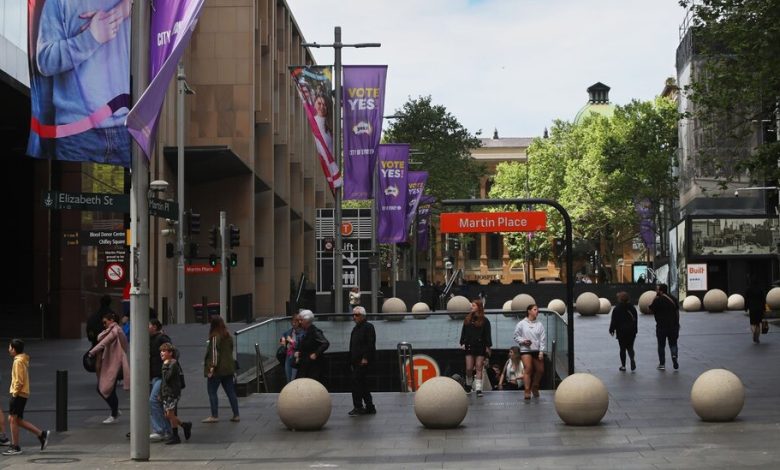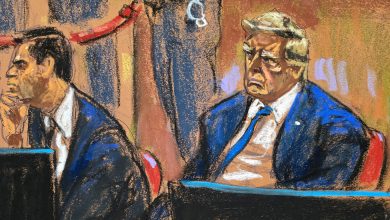A Polarized Australia Confronts ‘Trump Style Misinformation’

The ballots should, according to the official instructions, be marked with a “yes” or a “no.” A clear and legible “y” or “n” is also likely to be counted. So is a checkmark, for affirmative, but an “X” is considered too ambiguous by the authorities and does not count as a “no” vote.
This is how Australians have voted in constitutional referendums for decades. But as the debate over this month’s Aboriginal “Voice” referendum has become increasingly antagonistic and polarized, the process has come under attack.
For the first time, in as long as experts can remember, the leader of a mainstream political party in the country has cast doubt on the integrity of an electoral process. Conspiracy theories of a rigged election, the likes of which have led to the storming of government buildings in the United States and Brazil, have rippled from the far right of the political fringes, raising alarm. Election officials have fought back but faced vitriol on social media.
“We may look back at the Voice referendum as a turning point for when election lies and conspiracies went mainstream in Australia,” said Kurt Sengul, a lecturer at the University of Sydney who studies far-right populism. The current debate in the country, he added, was “the first significant Trump style misinformation and disinformation campaign we’ve seen in recent political history,” referring to former President Donald J. Trump.
And even though Australia is not at immediate risk of experiencing the kind of election denial seen in the United States, Mr. Sengul added, “That does not bode well for Australian democracy.”
The referendum, on whether to set up a body to advise Parliament on Aboriginal issues, has bitterly divided Australia and given rise to a slew of baseless claims on social media, including that the advisory body could seize property or land, or residents would be required to pay rent to Indigenous people if the referendum passed.
Caught in the turbulence is the matter of why a checkmark on a ballot counts as a vote while an “X” does not.
Longstanding legislation requires officials to count votes as long as the voters’ intent is clear, even if they do not follow the instructions on the ballot paper. Legal advice over the decades has confirmed that an “X,” which many people use on forms and documents to indicate a “yes,” does not show clear intent.
However, some pundits and politicians have suggested that the variance is unfair. The leader of the conservative opposition party, Peter Dutton, said that he did not want “a process that’s rigged.”
Mr. Dutton did not respond to requests for comment. Fair Australia, which is leading the opposition to the referendum said in a statement: “We understand the rules in relation to formality but believe they give an unfair advantage to the ‘Yes’ campaign. The responsibility for any erosion in trust lies with those who made the unfair rules, not with those who call them out.”
Unlike in the United States, where national elections are run by a patchwork of state and local officials, in Australia, they are administered by one independent agency, the Australian Electoral Commission, which enjoys broad trust and support and is widely praised by analysts.
The agency aims to make voting, which is compulsory in Australia, as accessible as possible. During federal elections, mobile voting stations are taken to remote Indigenous communities using helicopters, four-wheel-drive vehicles and even boats.
“The AEC is the gold standard for how you should run elections,” said Bruce Wolpe, who has written a book called “Trump’s Australia.” He added that when Australians go to the polls, “they know their vote will be counted accurately and they’ll abide by the results, and that’s a big deal for how this democracy works in contrast to the U.S.”
The commission moved quickly to counter inaccurate claims about the referendum, responding to posts on social media, sending officials to TV and radio shows, and condemning much of the commentary around the issue as “factually incorrect.”
In addition to dealing with the issue of check and “X” marks, during this referendum campaign, the commission has debunked suggestions that ballot papers would not be securely stored, pushed back against claims that the referendum would not go ahead and sparred with users who flushed information booklets down toilets, sometimes responding to hundreds of social media comments a day.
But even as officials have become more assertive in fighting disinformation, their task is only getting harder.
For several years now, experts have watched the political polarization and spread of voting fraud conspiracies in the United States and worried that such rhetoric would leech into Australia’s domestic politics because of the two countries’ close ties.
“It is an ongoing concern that we’re seeing groups draw inspiration from U.S. politics that is highly polarized and attempt to export those tactics here,” said Josh Roose, a political sociologist at Deakin University in Melbourne.
Tom Rogers, the electoral commissioner, said that after Australia’s 2019 federal election, he “really started to worry about what we were seeing globally.” His agency realized it wasn’t enough to simply run elections fairly and well.
“You’ve got to tell people what you’re doing,” he said.
The commission started running digital literacy campaigns to educate voters about fake news, working with social media companies and countering incorrect claims about the electoral process online.
Its strategy came to national attention during last year’s federal election, when its tongue-in-cheek humor — including beseeching voters not to draw an “eggplant emoji” on their ballot papers — drew both acclaim and criticism.
On social media, the agency tries to respond to as many comments as possible — even ones that may seem outlandish, said Evan Ekin-Smyth, who leads that effort.
“We take an approach of: Unless you’re going to engage in something that’s deliberately false, deliberately bad faith, we’ll give a response,” he said. “Why not? We’re there to provide fact-based information about the process that we run. No matter how crazy a theory might seem, some people believe it.”
However, the agency dialed back the humor for the referendum because it was experiencing new levels of attacks on social media, including, for the first time, threats of physical harm, Mr. Rogers said.
Mr. Ekin-Smyth admitted that the agency’s strategy probably would not change the minds of everyone determined to believe conspiracy theories, but he hoped that by injecting accurate, factual information into the discussion, the commission could help stop these theories from spreading further.
“Does it feel like we’re pushing a boulder up a hill? Sort of, sometimes,” he said. But “if we’re keeping that boulder from rolling down the hill, that’s pretty good, isn’t it?”



